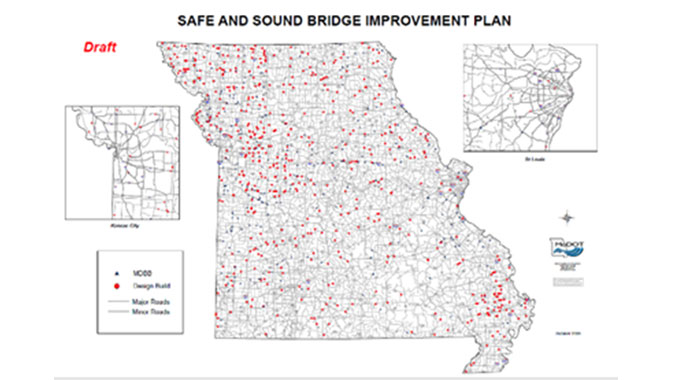
| Name of Agency | Missouri Department of Transportation (MoDOT) |
|---|---|
| Location | Statewide (at least one in every county) |
| Project Delivery Method | Design-Build (D-B; 554 bridges) Design-Bid-Build (D-B-B; 248 bridges) 802 Total Bridges |
| Procurement Method | Best Value, Design-Build; Low Bid, Design-Bid-Build |
| Total Project Cost | $685 million ($487 million for D-B, $198 million for D-B-B) |
| Funding Source | Federally Funded with GARVEE bonds |
| Construction Schedule | There are 802 bridges, with a program goal to complete construction in 5 years. The D-B portion required 3 years of construction to complete. The D-B-B started 1 year earlier and finished at the same time. Average road closure was 42 days. Road closures were necessary to make program affordable. Without closures, the program would have been reduced by 40%. |
| Project Description | In the mid-2000s, over 10% of Missouri's bridges were rated serious (Condition 3) or poor (Condition 4) under the Federal Highway Administration (FHWA) National Bridge Inspection Standards. The timeframe to repair the approximately 1,100 bridges using MoDOT's standard capital programming approach was too long. Missouri accelerated the rehabilitation or replacement of 802 of these bridges under the Missouri Safe & Sound Bridge Improvement Program. MoDOT pursued a Public-Private Partnership to construct and maintain the bridges for 20 years. That procurement was found unaffordable during a major recession in 2008. Subsequently, the program was delivered by more traditional financing and project delivery. The program was completed with GARVEE-bond financing and a combination of D-B and D-B-B procurement. Five hundred fifty-four of the bridges, known to be replacements, were bundled into a single D-B project. The remaining 248 bridges, primarily major rehabilitations, were delivered by conventional D-B-B. Those bridges were bundled into bid packages of 2 to 10 bridges each. The deck sealing and bridge painting contracts are true preventative maintenance contracts. DelDOT takes a programmatic approach to prioritizing work in a timely manner. The goal is to keep decks sealed and steel beams painted to prevent deterioration. The deck sealing contract focuses on decks with black steel reinforcement that are in good condition, and the program is aimed at sealing these decks every 5 years. The locations and quantities are determined in the design phase of the program. Plans are put together in a proposal format and awarded based on LB. The contract for the D-B project was not prescriptive and allowed for construction schedule flexibility. The RFP was written to minimize closure duration and overall project timeline. The bridges that were constructed met the requirements in the request for proposal but did not follow typical MoDOT details, leading to concerns about durability and more maintenance than what is typical of MoDOT standard bridge types. They were constructed faster than traditional MoDOT bridges due to the design details that were used. The D-B-B contract consisted of 248 bridges bundled by structure type, location, and schedule. The first 100 bridges were considered "fast start" bridges. These were mostly superstructure replacements or rehabilitation projects with minimal right-of-way needs and coordination. The bundles were sized and scheduled to allow a spectrum of local contractors to perform the work. (Most of the 802 bridges were constructed by "local" contractors. The D-B contractor self-performed a small percentage themselves.) Overall, the program was very successful. MoDOT was able to replace 802 bridges in just 4 years. |
| Project Website | http://www.modot.gov/safeandsound/districts.htm |
| Program Goals | To quickly reduce the percentage of bridges in poor condition on the local system. |
|---|---|
| Bridge Selection Criteria |
|
| Delivery and Procurement Method | D-B, Best Value |
| Funding Sources, Financing Strategy | Federally Funded with GARVEE Bonds |
| Environmental, Right-of-Way, and Utility Considerations | D-B Contract:
D-B-B Contract:
|
| Risks | D-B Contract:
D-B-B Contract:
|
| Owner Management/Quality Assurance |
D-B Contract:
D-B-B Contracts:
|
| Stakeholder Communication |
|